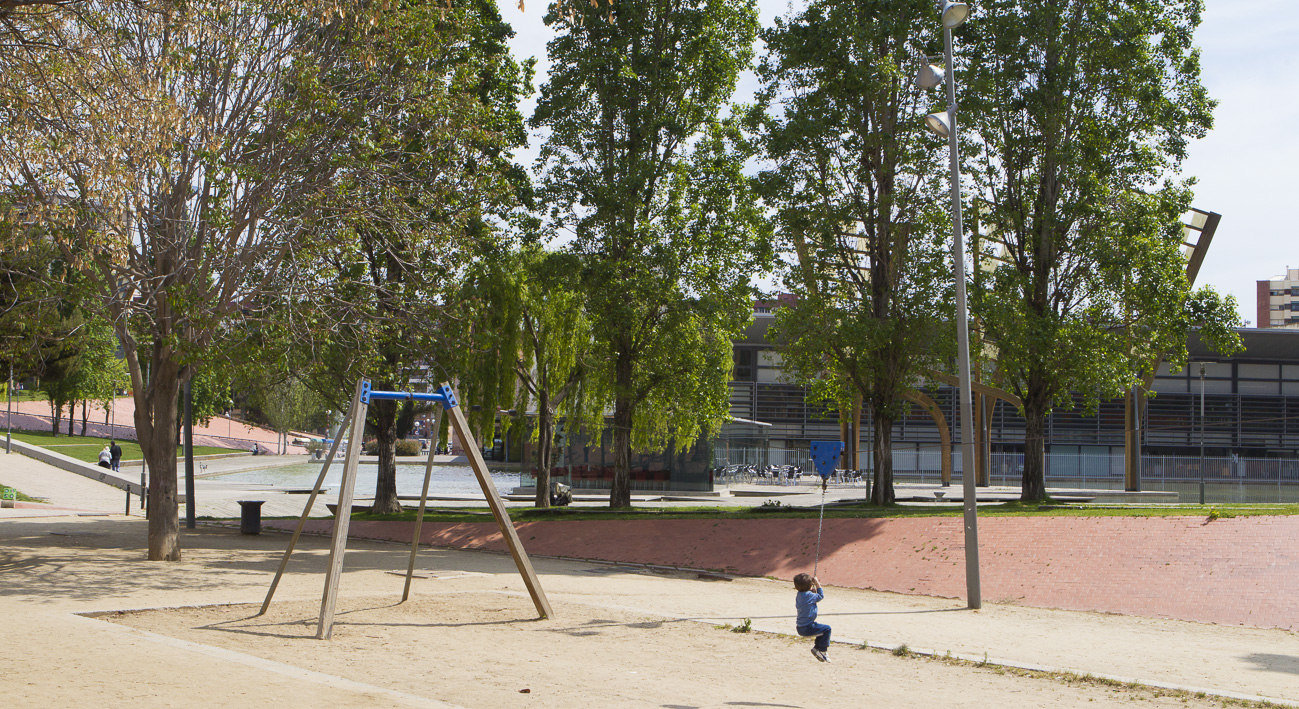This is the city’s second largest green space, boasting 17 hectares. An area that invites visitors to take a stroll and contemplate the lush vegetation it houses. You can find over 1,000 trees made up of 49 different species, as well as a palm grove unique to the city. The park’s other unique feature is its water, in the form of fountains and big lakes.
It has many uses as a leisure, walking and rest area, as a thoroughfare and neighbourhood connection point for pedestrians, and as the site of the district offices, the Fòrum Tecnològic Nord business technology centre, a city-police station, schools and neighbourhood centres.

History
Parc Central de Nou Barris houses the old Institut Mental de la Santa Creu, a mental asylum that closed in 1986. It occupied a 120-hectare estate, only a part of which has been conserved, with a structure that provided interior landscaped courtyards. Today it houses the district offices.
If you go through the park, you will pass by other facilities with a lot of history behind them, such as Ca n’Ensenya, an old 18th-century farmhouse that has been a neighbourhood centre since 1996. You will also see Can Carreras, an old 17th-century farm, originally known as Can Sala, and now owned by the Council.
Visitors can make out part of the Dosrius aqueduct too, which used to carry water from the Maresme to Barcelona back in 1870. Its only remaining section has been turned into a crossable bridge.
Ever since the park officially opened in 1999, its charm and grandeur, and the fact that various facilities are located there, have encouraged residents of the surrounding neighbourhoods (Can Peguera, Guineueta, Turó de la Peira and Porta) to spend time there. The park’s design was rewarded with the 2007 International Urban Landscape Award.

Biodiversity
The park’s characteristic trait are its numerous species of trees, grouped into small, easily recognisable groups, and it also has Barcelona’s largest palm grove. Particularly notable are the large plane trees along C/ Doctor Pi i Molist, which open the way to one of the park’s entrances. You can also see a group of silk floss trees, jacarandas and tipu trees spread out over several slopes. There are large ombu trees, river oaks, blue Atlas cedars, holm oaks, cypresses and a few eucalyptuses too. The flowerbeds are covered with abundant meadow vegetation, such as bottlebrush, spurge olive and fragrant geraniums.
There are also a further three groups of flowering trees: evergreen magnolias, Judas trees and pink sirises.
Besides all that, Parc Central de Nou Barris holds the largest concentration of plant species in the city, including as many as 29 different types of palm trees from around the world, with 157 specimens in all. One of the palm trees is listed in the Catalogue of Trees and Palm Trees of Local Interest. It is an Australian palm (Livinstona australis).
If we bear in mind their geographical provenance, their variety is quite spectacular. They come from Oceania and include kentia palms, Australian palms and Asian bangalow palms as well as palms native to Japan, true Sago palms, latania palms and chusan palms. There are other specimens such as dwarf palms and broadleaf lady palms too.
By far the most palm trees come from Central America, such as the Guadalupe palms, several types of butia from Brazil, Jubaeas and three types of sabal that grow between Mexico and the United States. As for African palms, you will find wild date palms and date palms, triangle palms and bamboo palms. There is even a European palm, the Mediterranean dwarf palm.

Art and Architecture
Right by the first ornamental fountain is the Palma i diapasó, a sculptural ensemble designed for the park that you keep coming across on your way round. This ensemble of triangular inspiration and spirit interacts with the setting not just as a monumental or ornamental feature but also as a piece of urban furniture, folding up to create pergolas and shaded areas over the paths and secluded spots in the garden. Palma i diapasó has managed to integrate itself into the collective imagination. It has become an aesthetic identity symbol that goes beyond the park’s boundaries and established itself in other parts of Nou Barris.

Landscaping and Design
In Parc Central de Nou Barris triangles are essential for understanding the garden and describing the park from Plaça de Karl Marx to the area below the old Institut Mental de la Santa Creu pavilions. The flowerbeds that set the boundaries of the greenery, the bases of the fountains, the sculptures, the wooden platforms over the sheets of water and the slopes covered in tiles and ceramics that bridge changes in the ground level of the park are all triangular.
-
- Phone number
- Tel.: 010
-
- Titularity
- Public center
- Address:
- Pl Major de Nou Barris, 1
- Districte:
- Nou Barris
- Neighborhood:
- la Guineueta
- City:
- Barcelona
- Sections of this equipment
- Espai per a gossos deslligats al parc central de nou barris
- Àrea de joc infantil
- Àrea de joc infantil
- Àrea de joc infantil
- Taules ping-pong
- Àrea de joc infantil
- Àrea de joc infantil
- Àrea de joc infantil
- Àrea de joc infantil
- Àrea de joc infantil
- Àrea de joc infantil
- Àrea de joc infantil
- Llac
- Àrea d'esbarjo per a gossos
- Àrea de joc infantil






